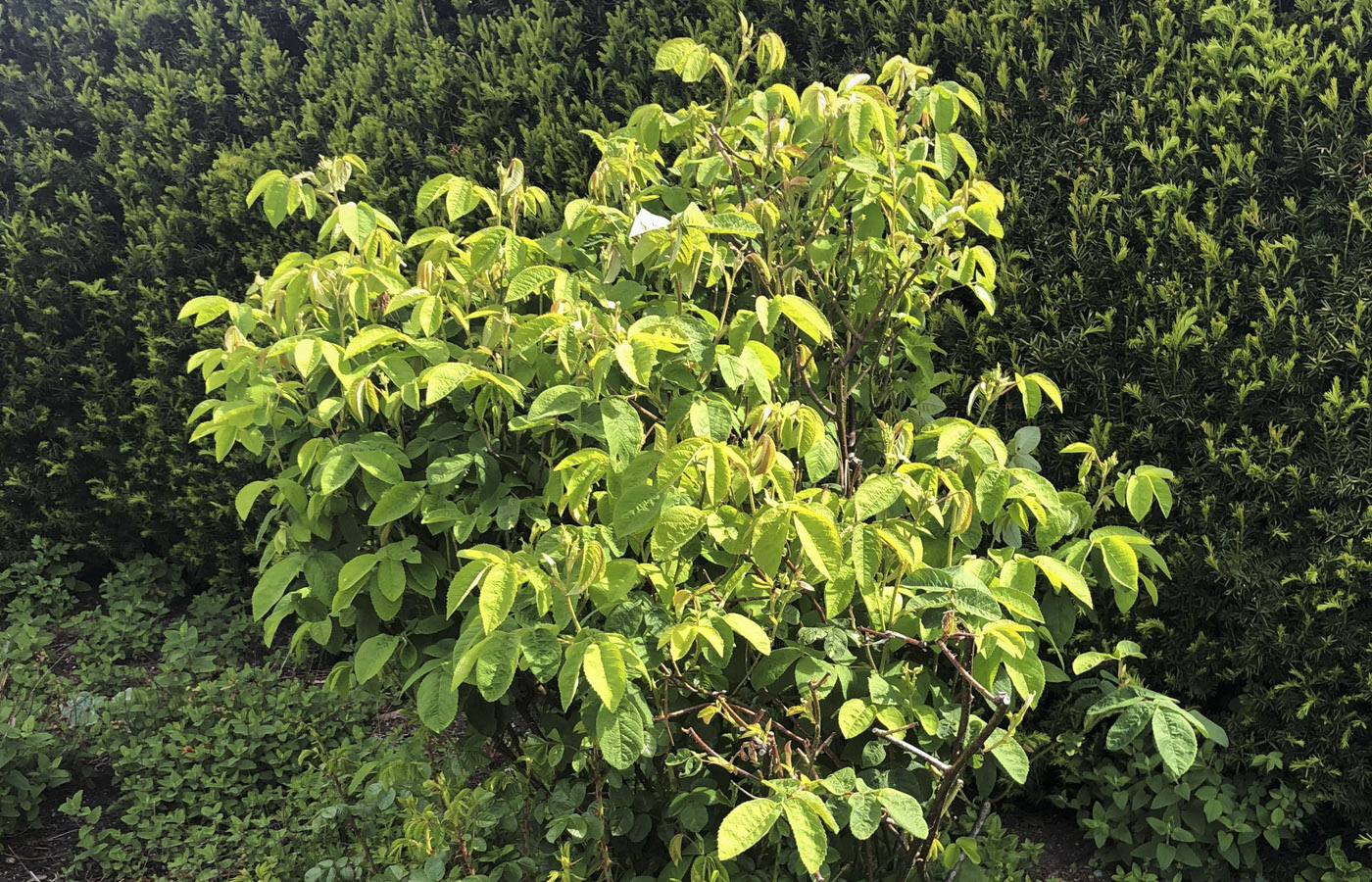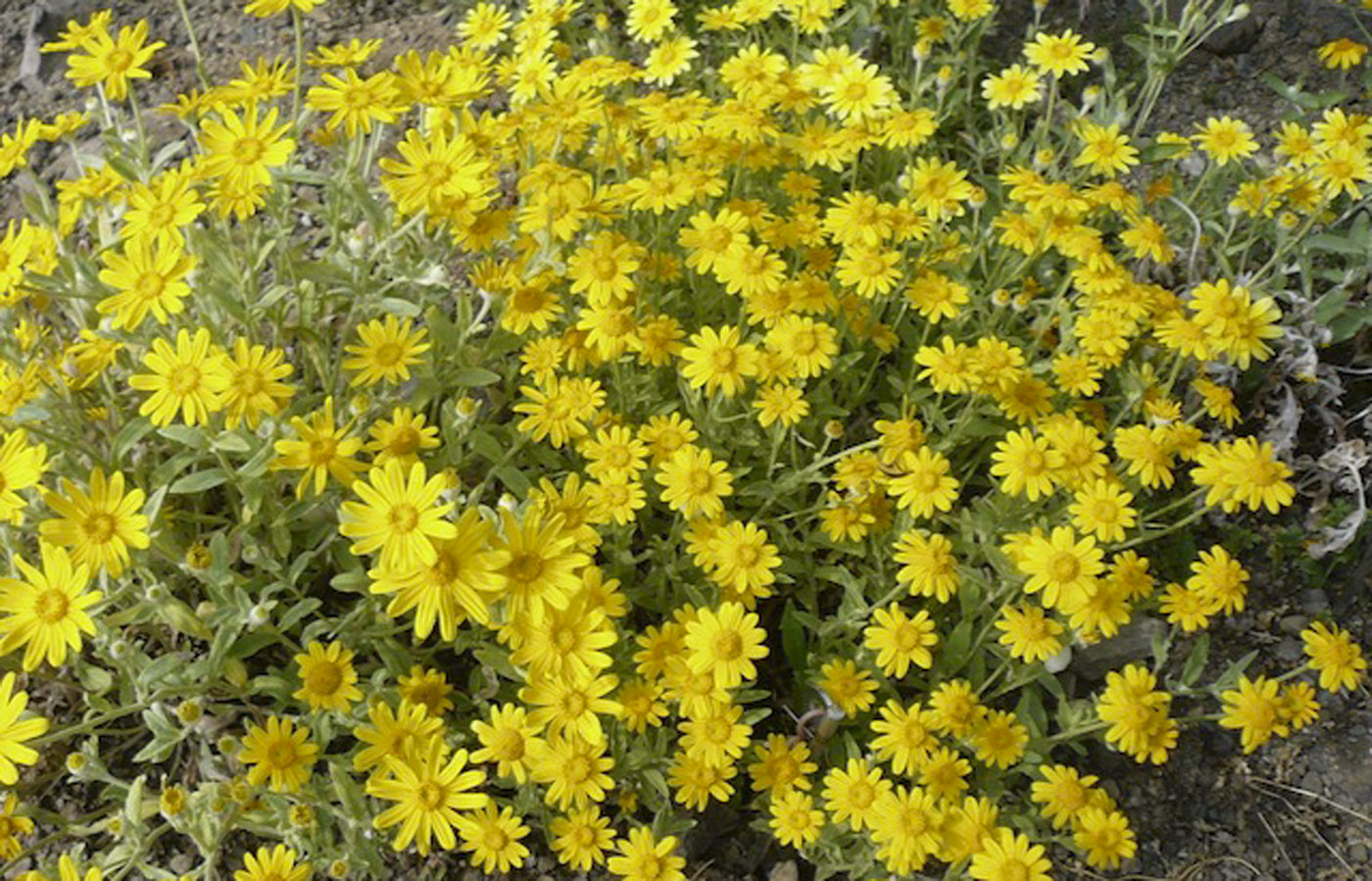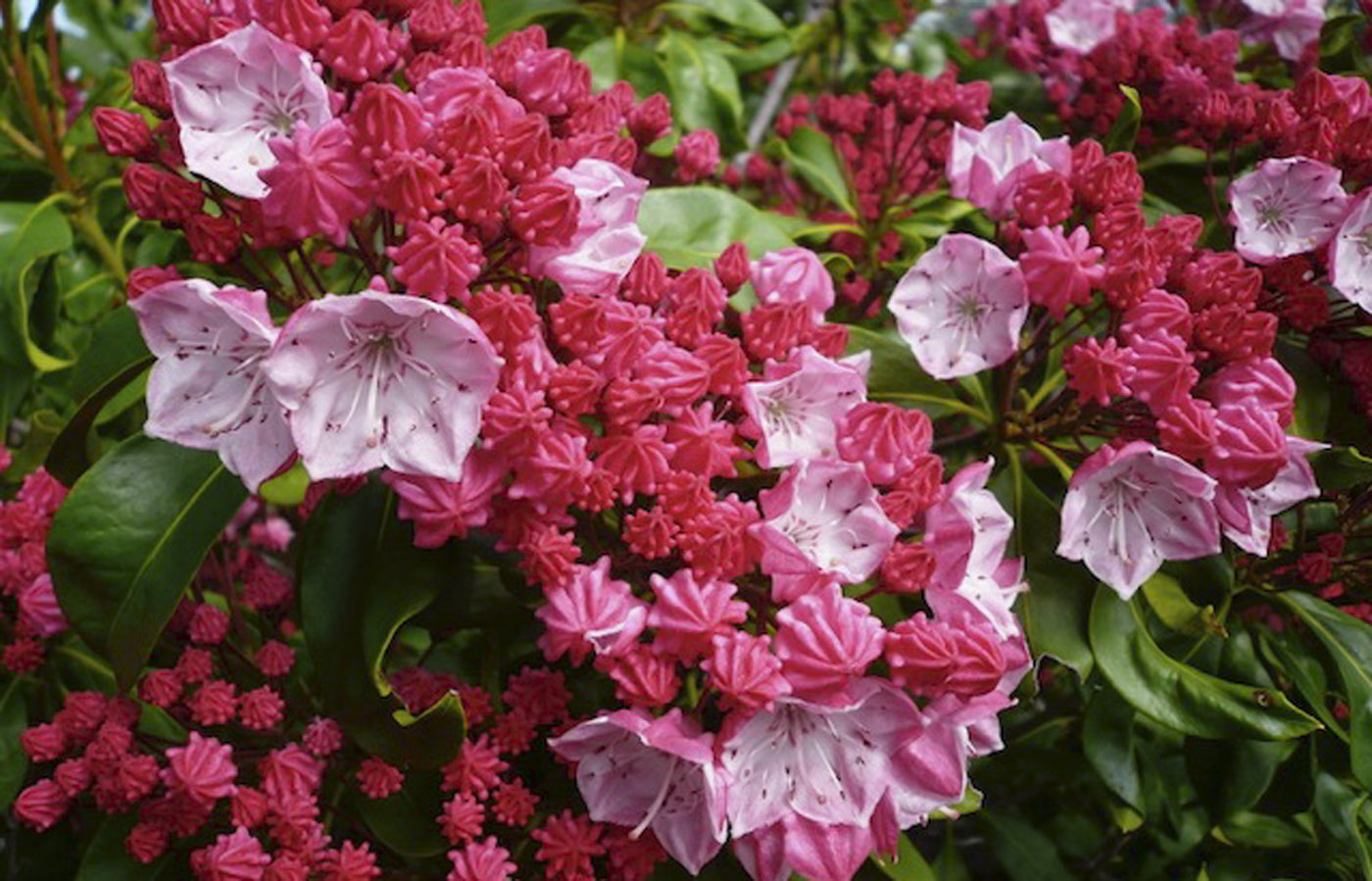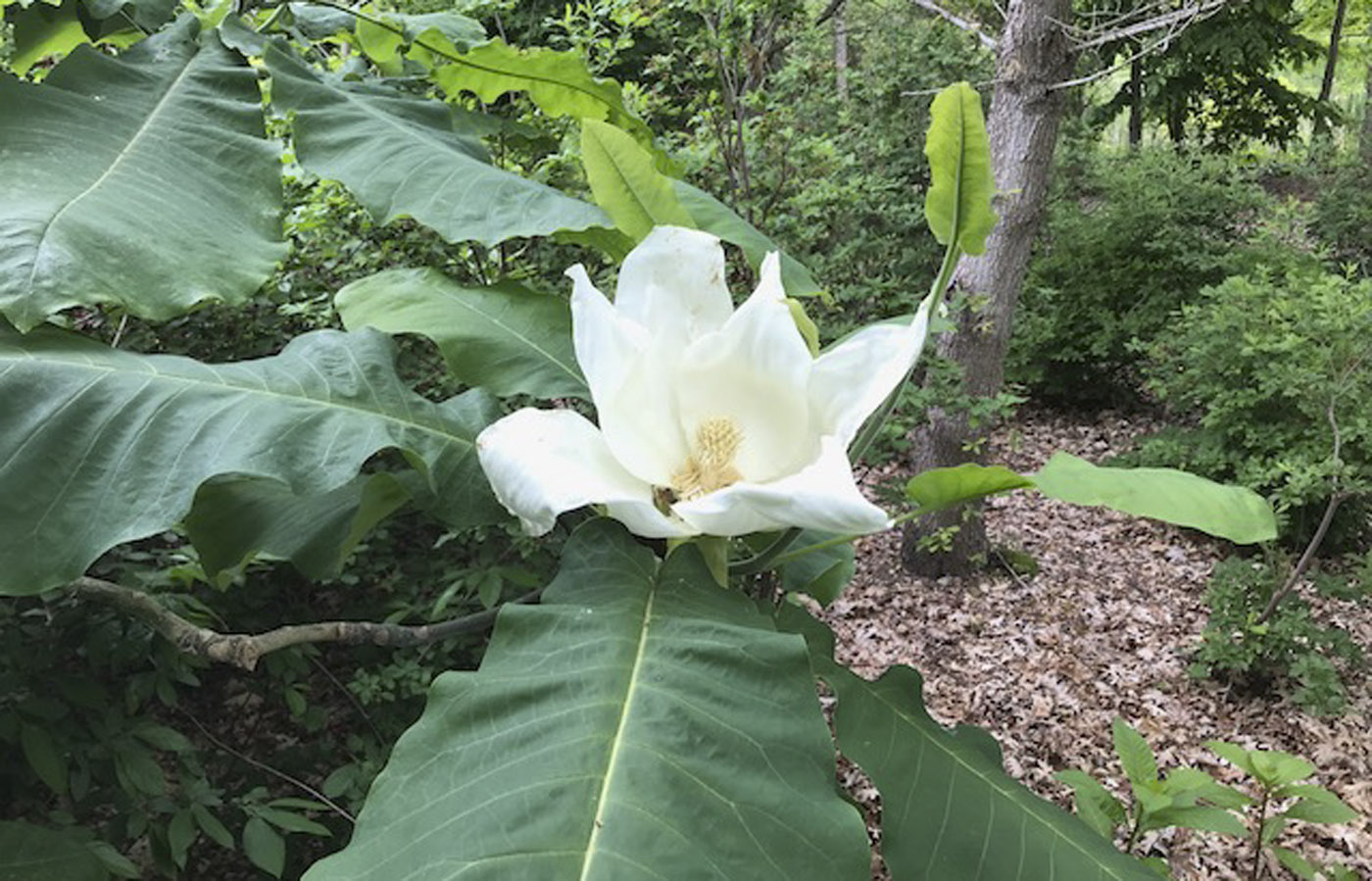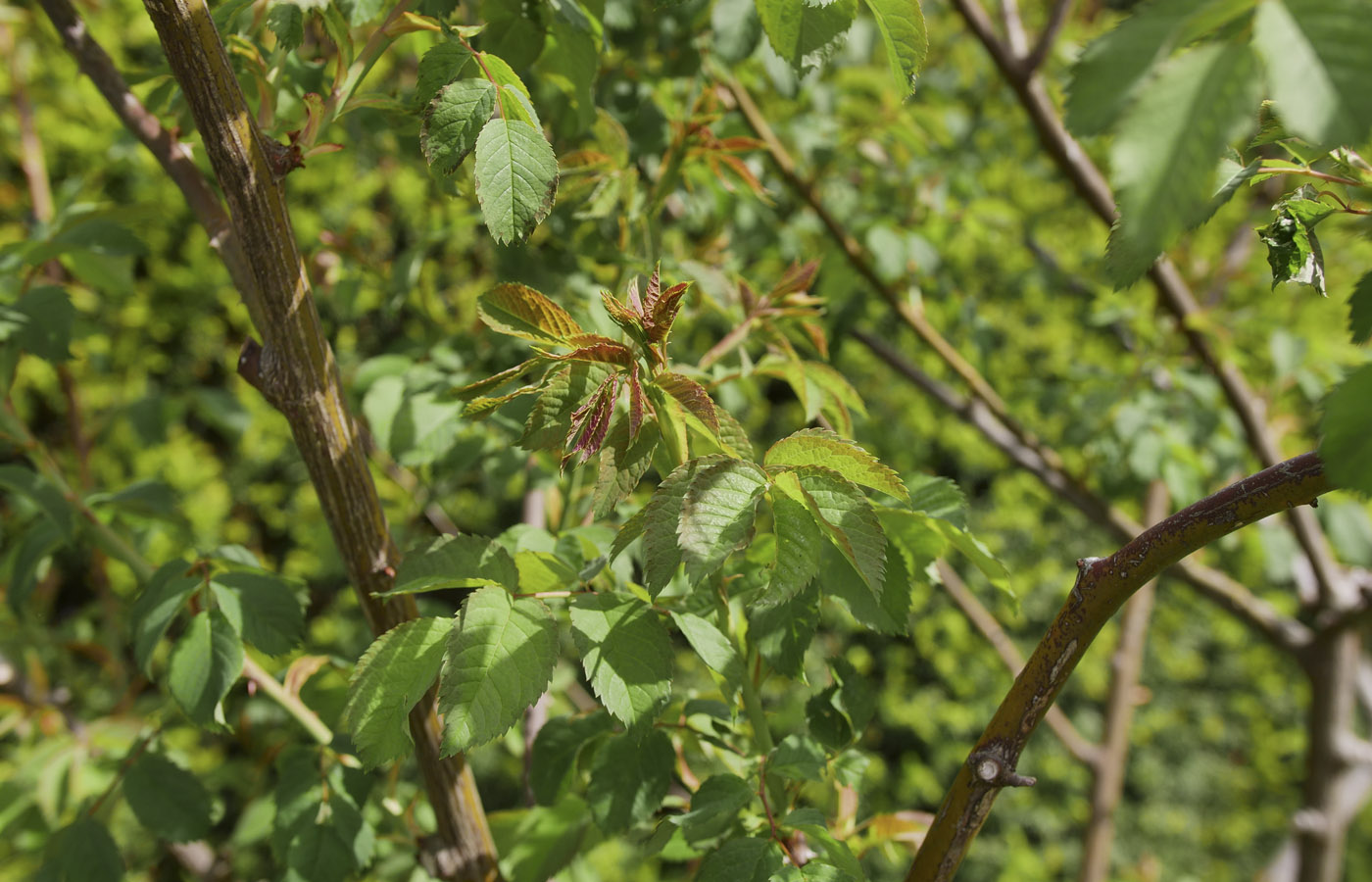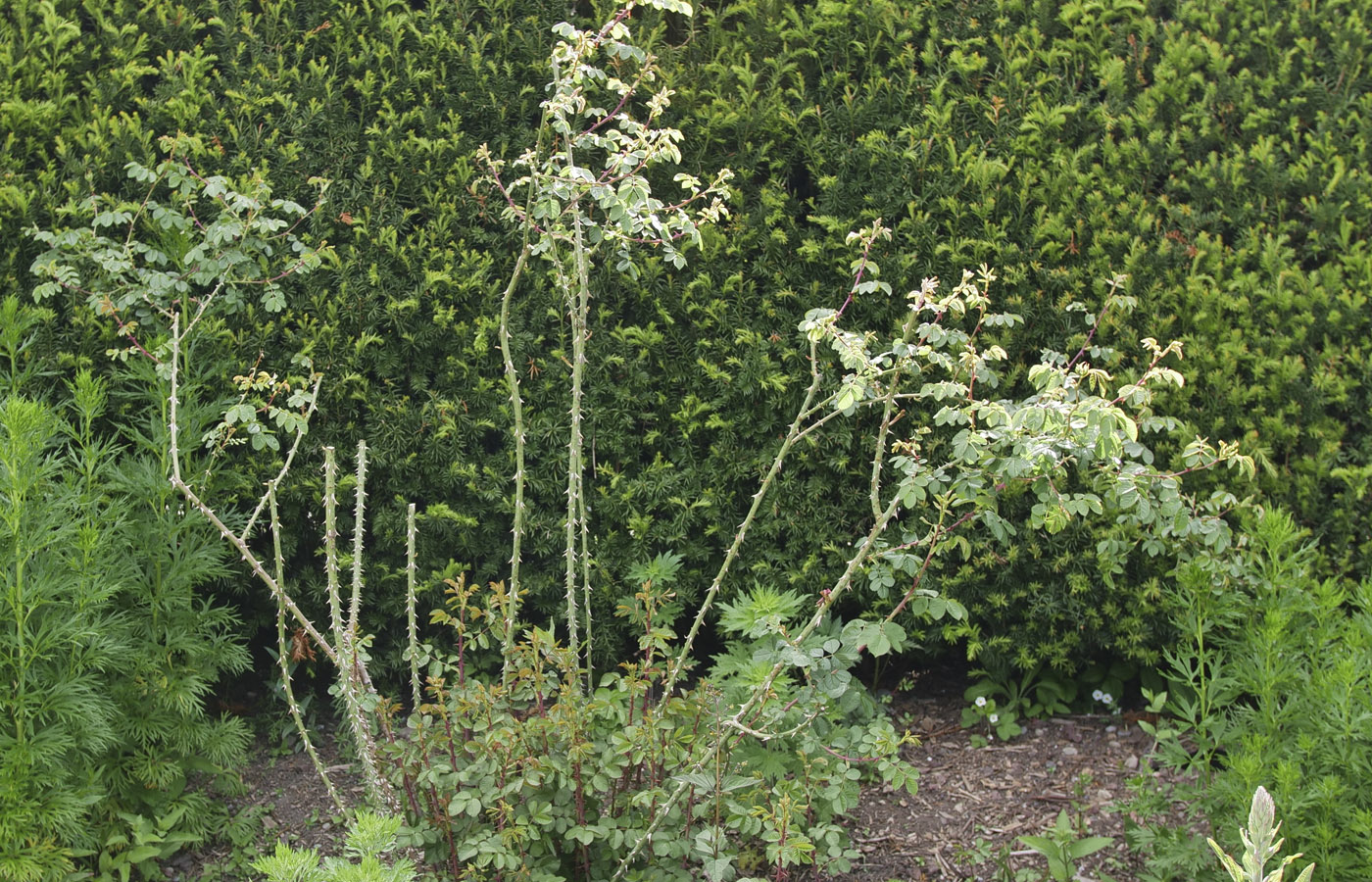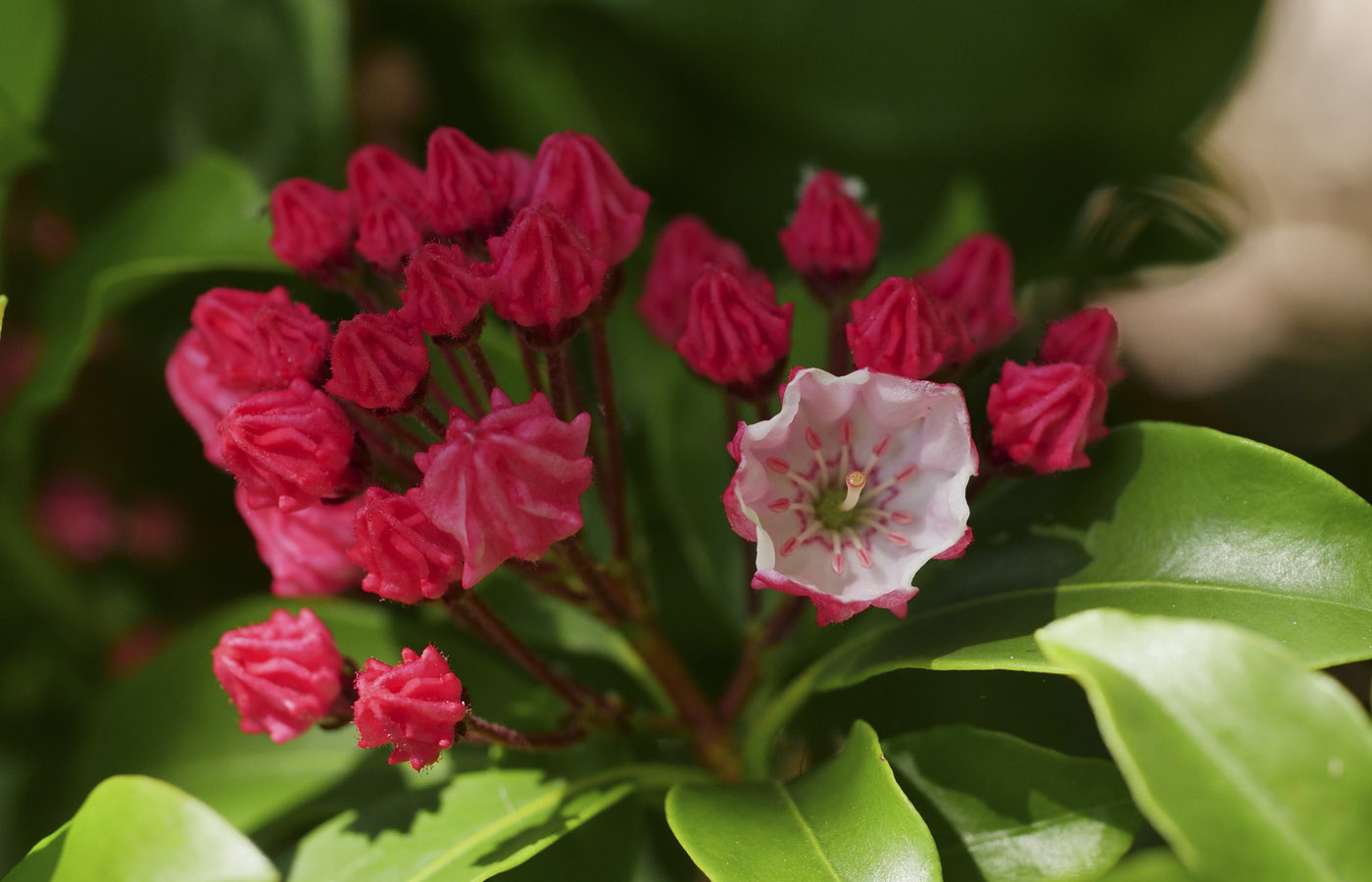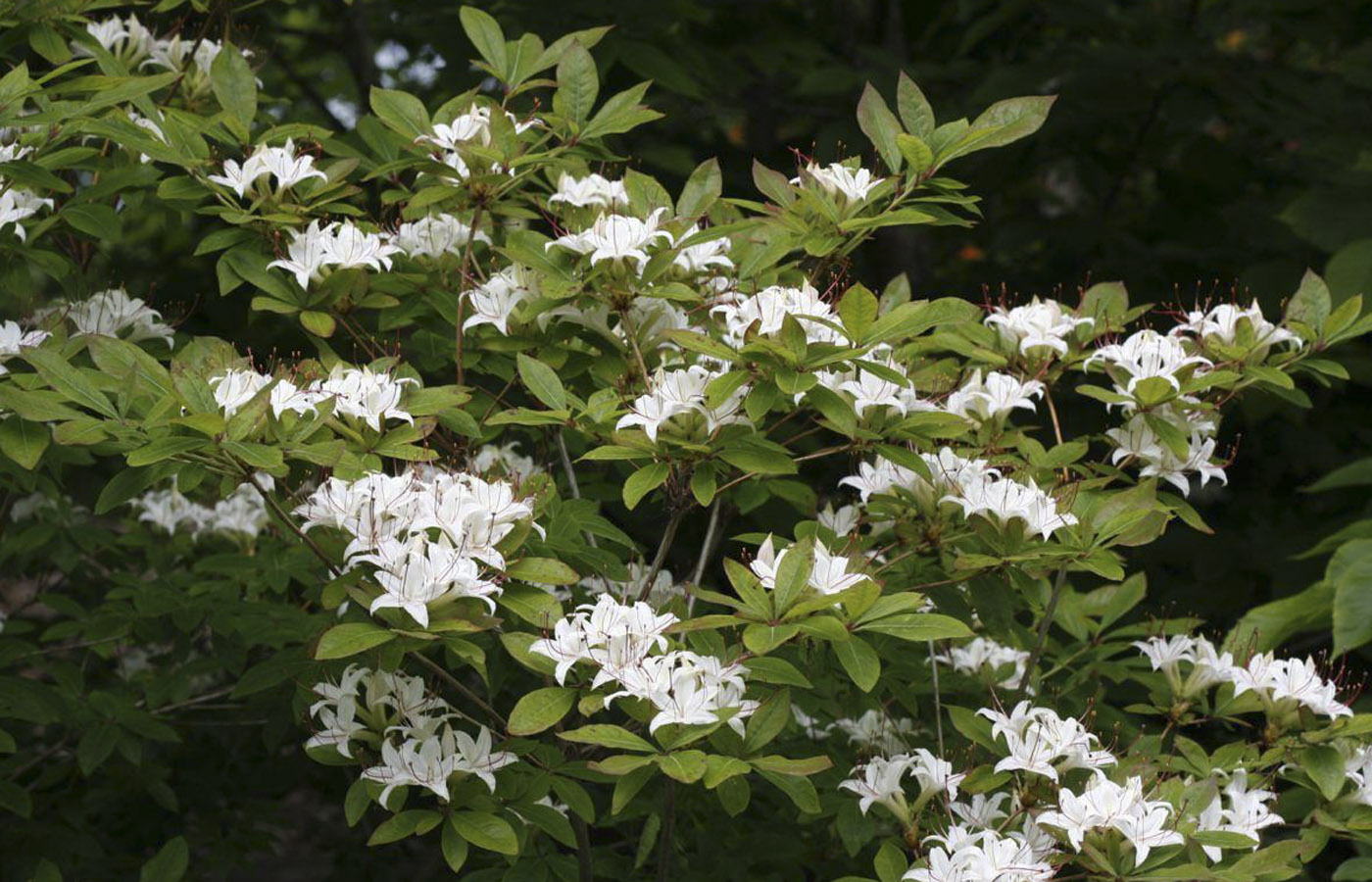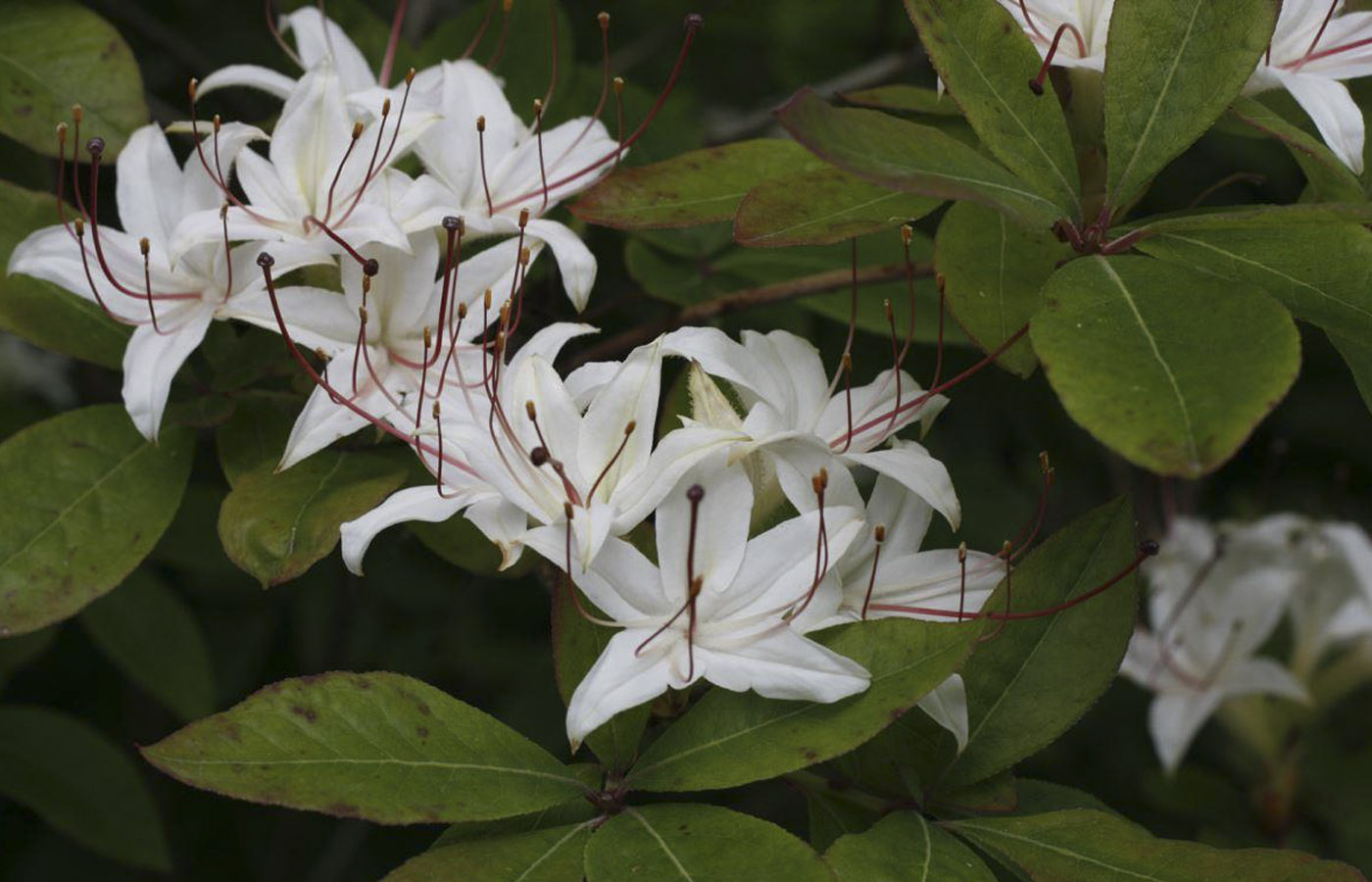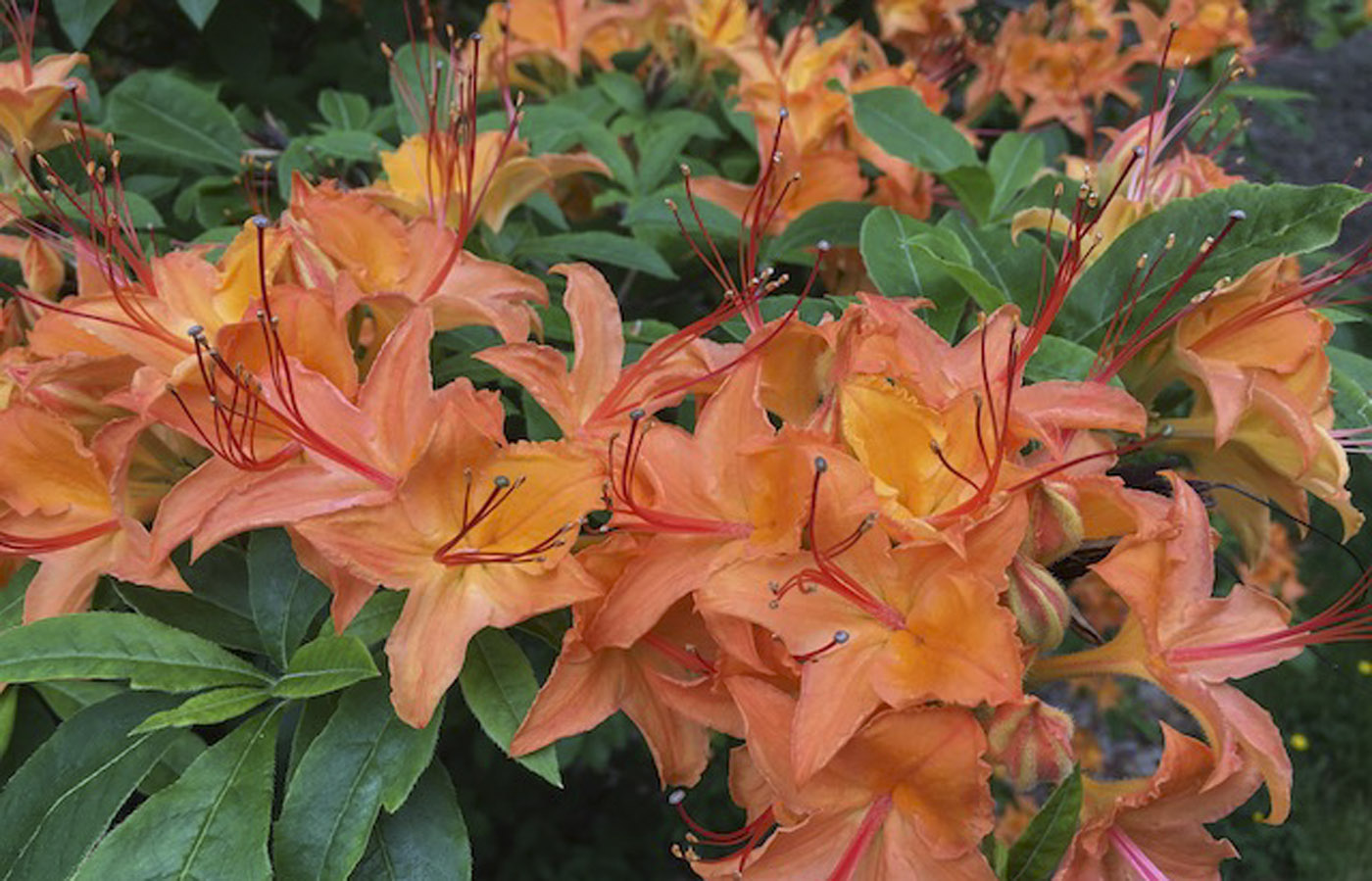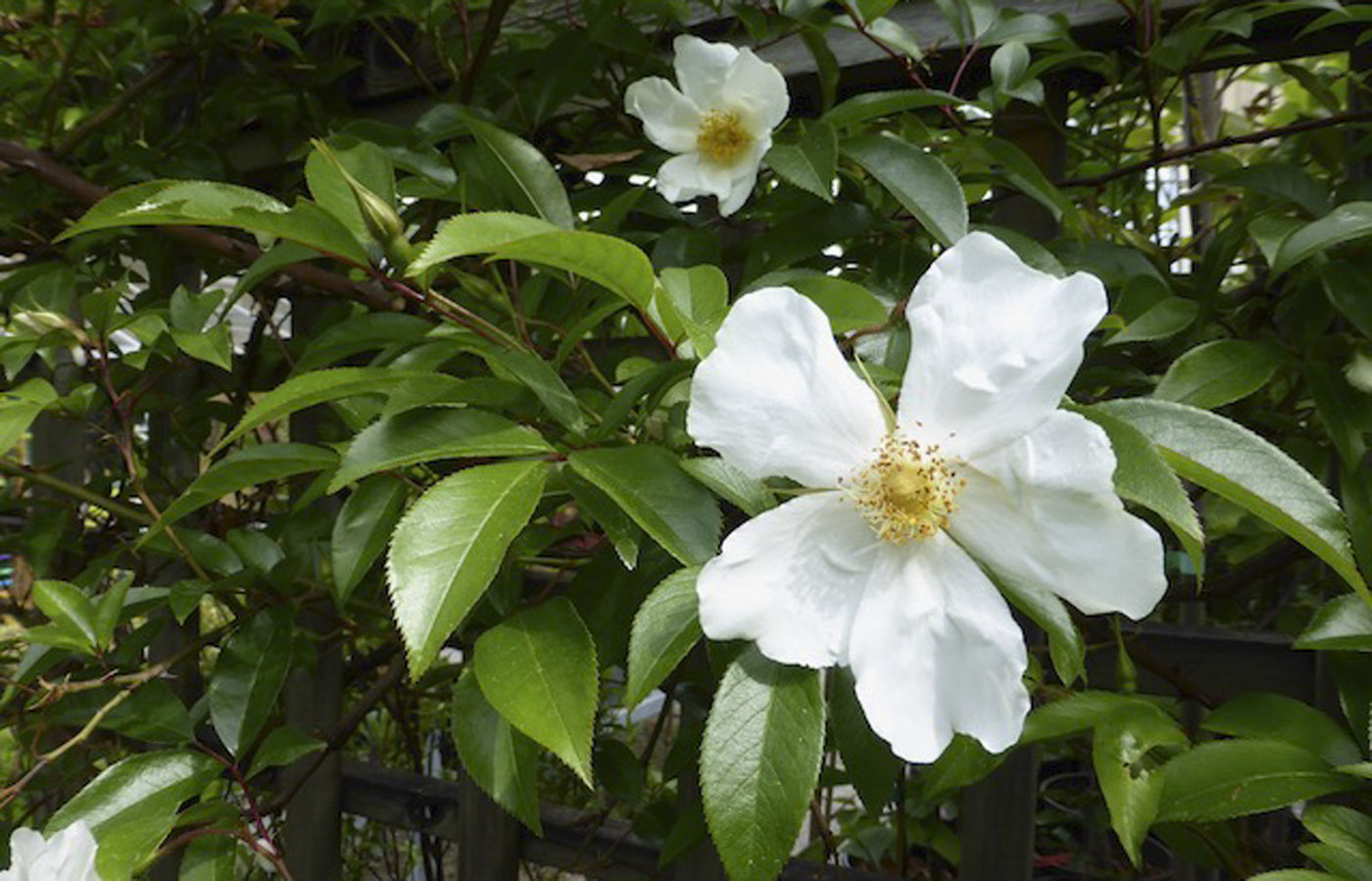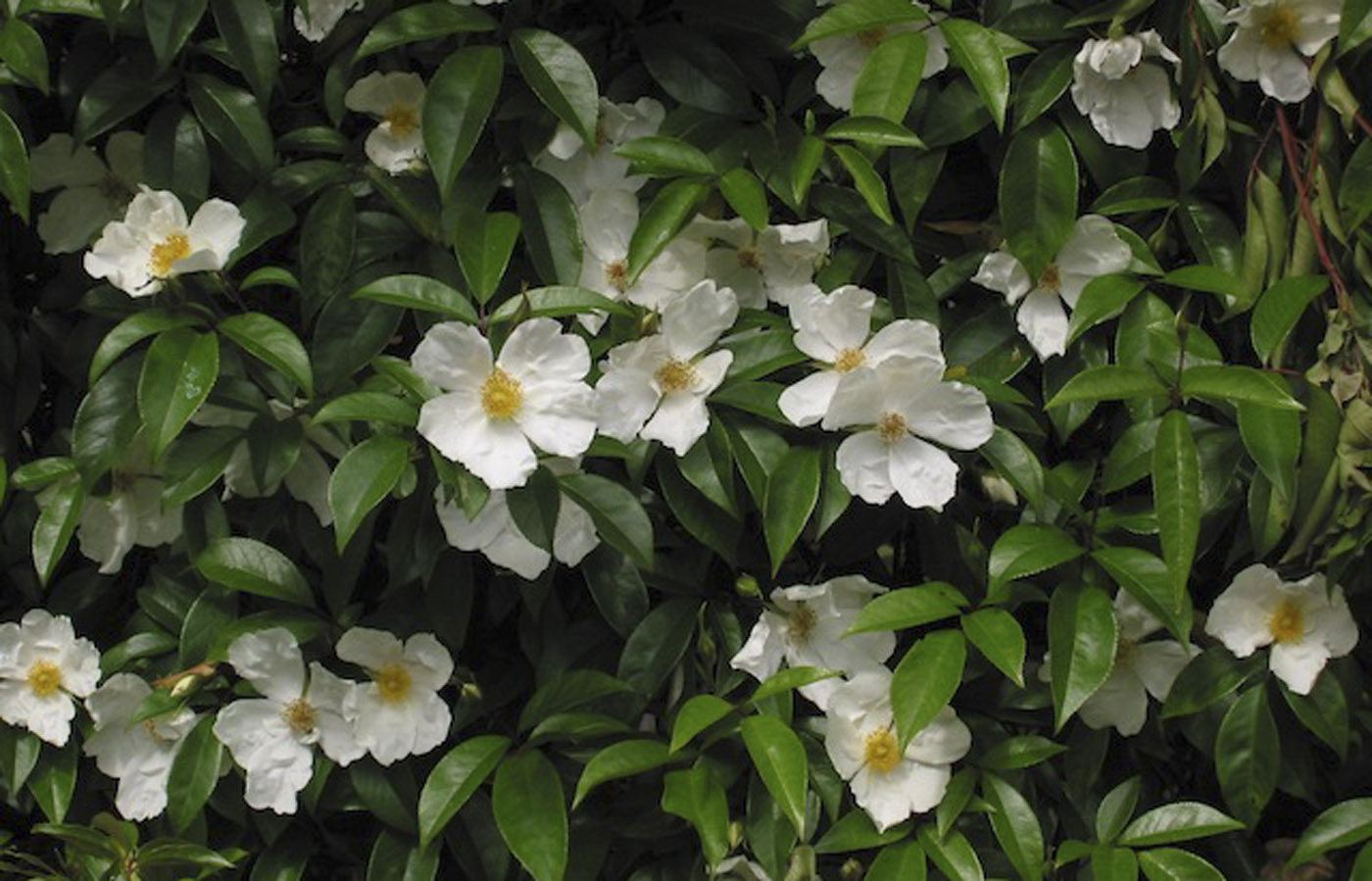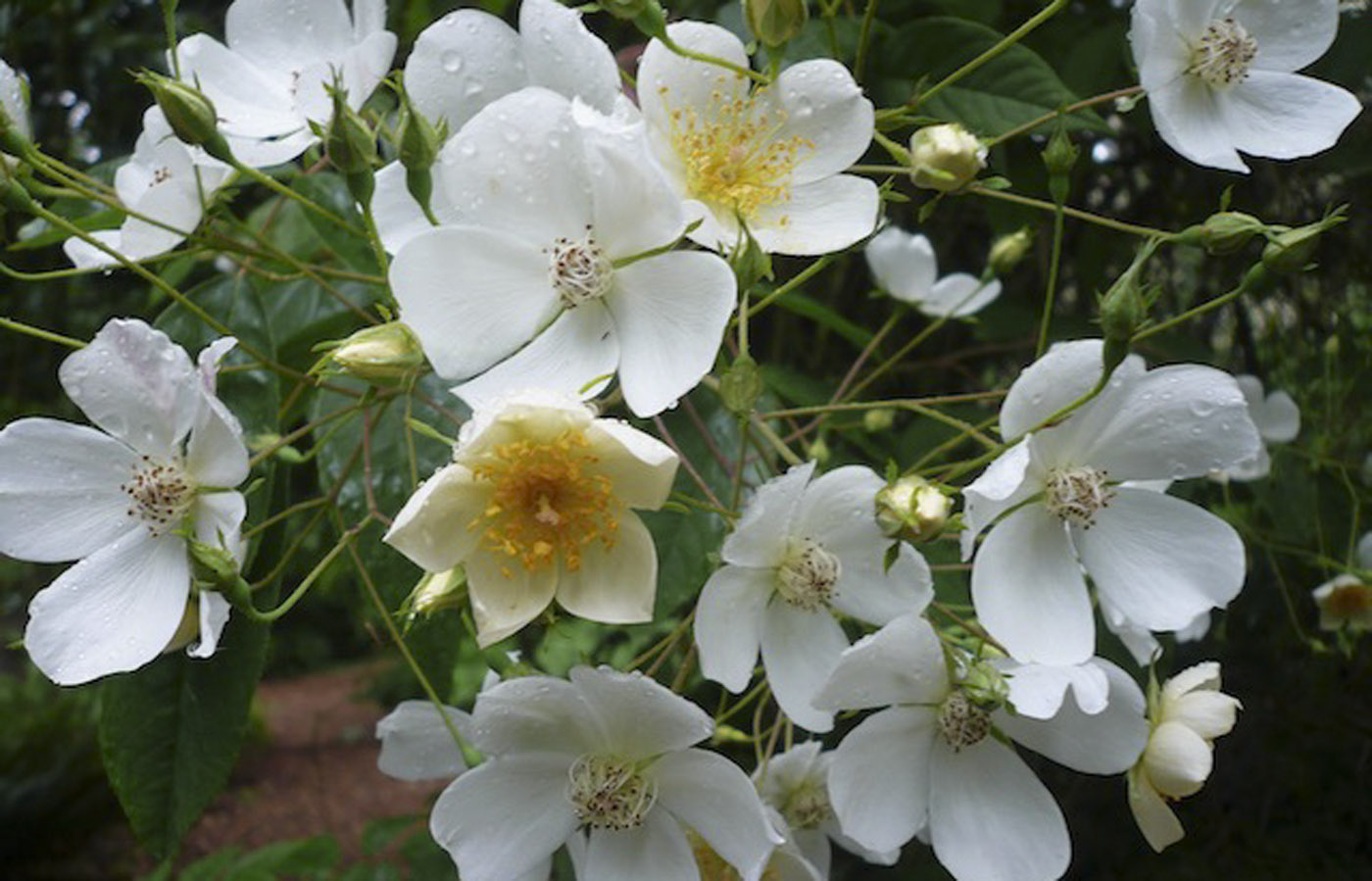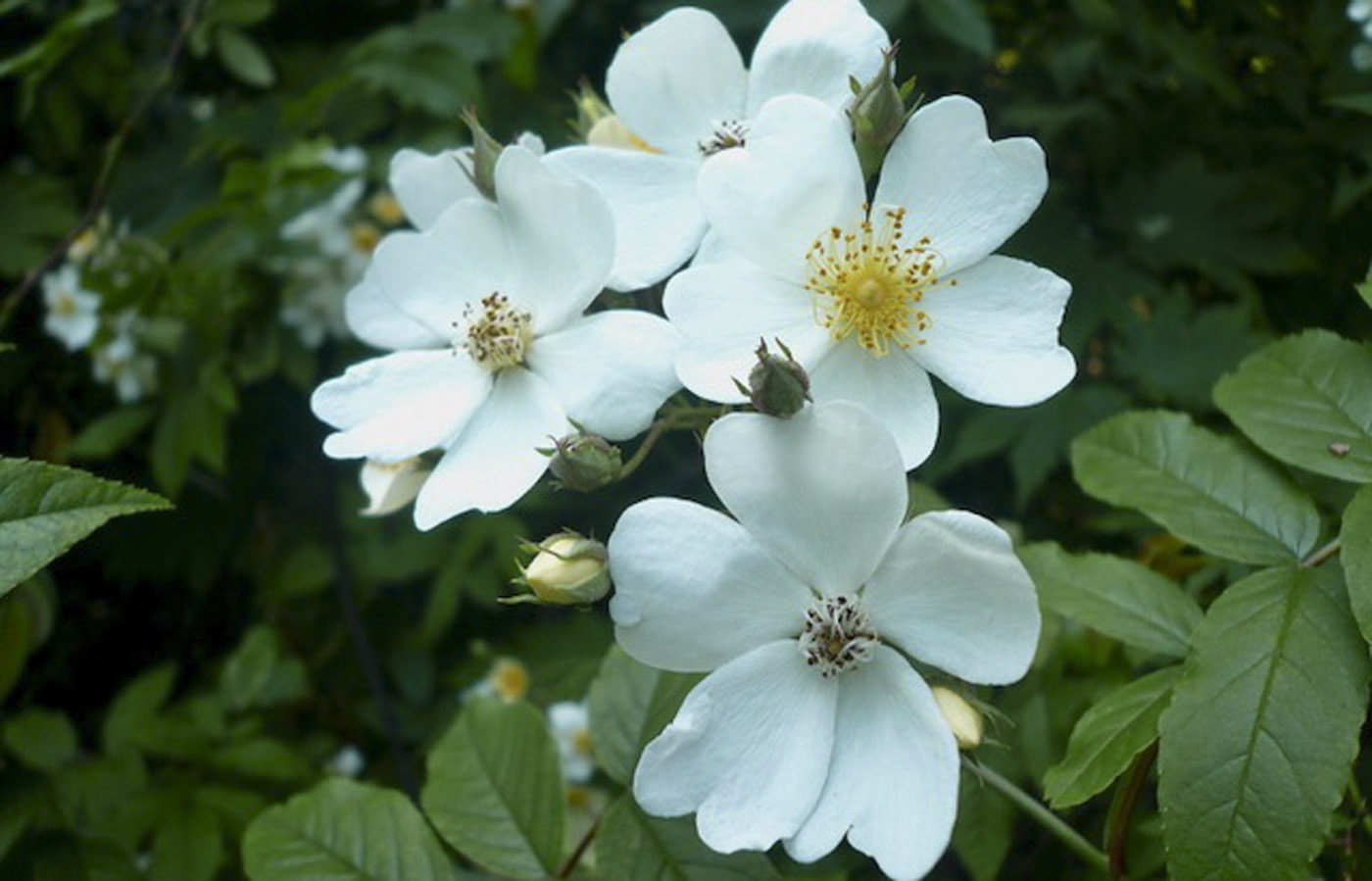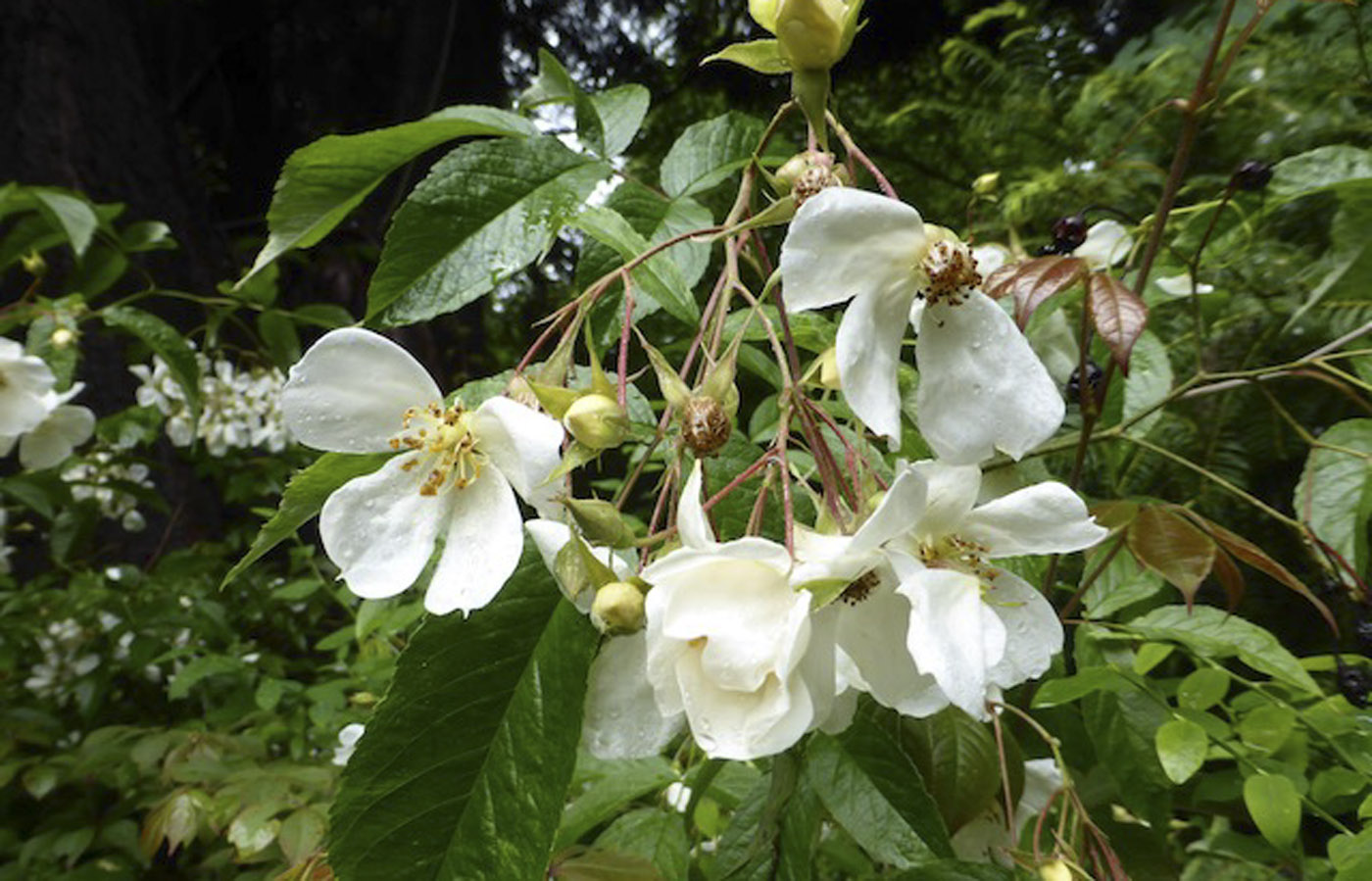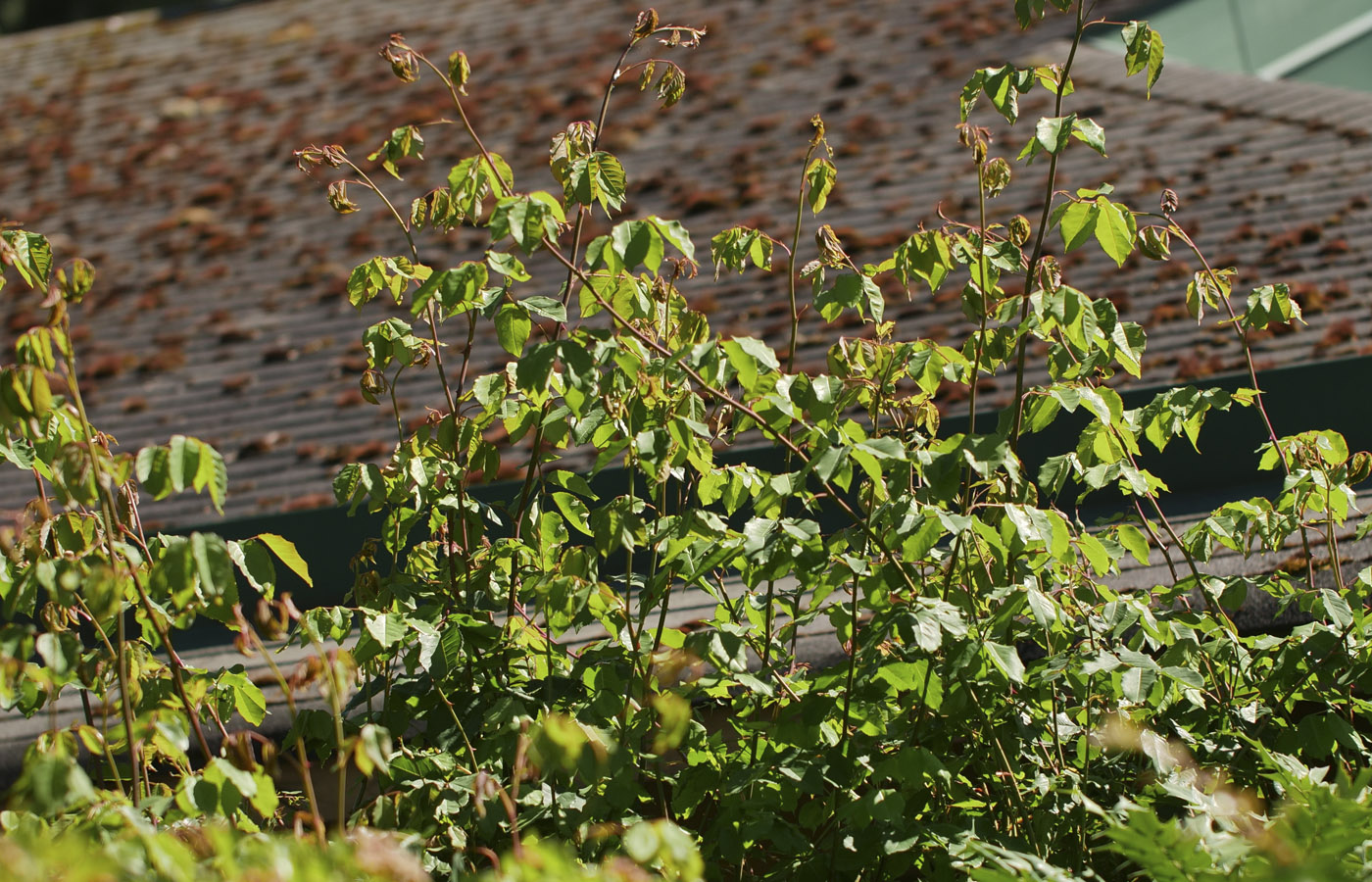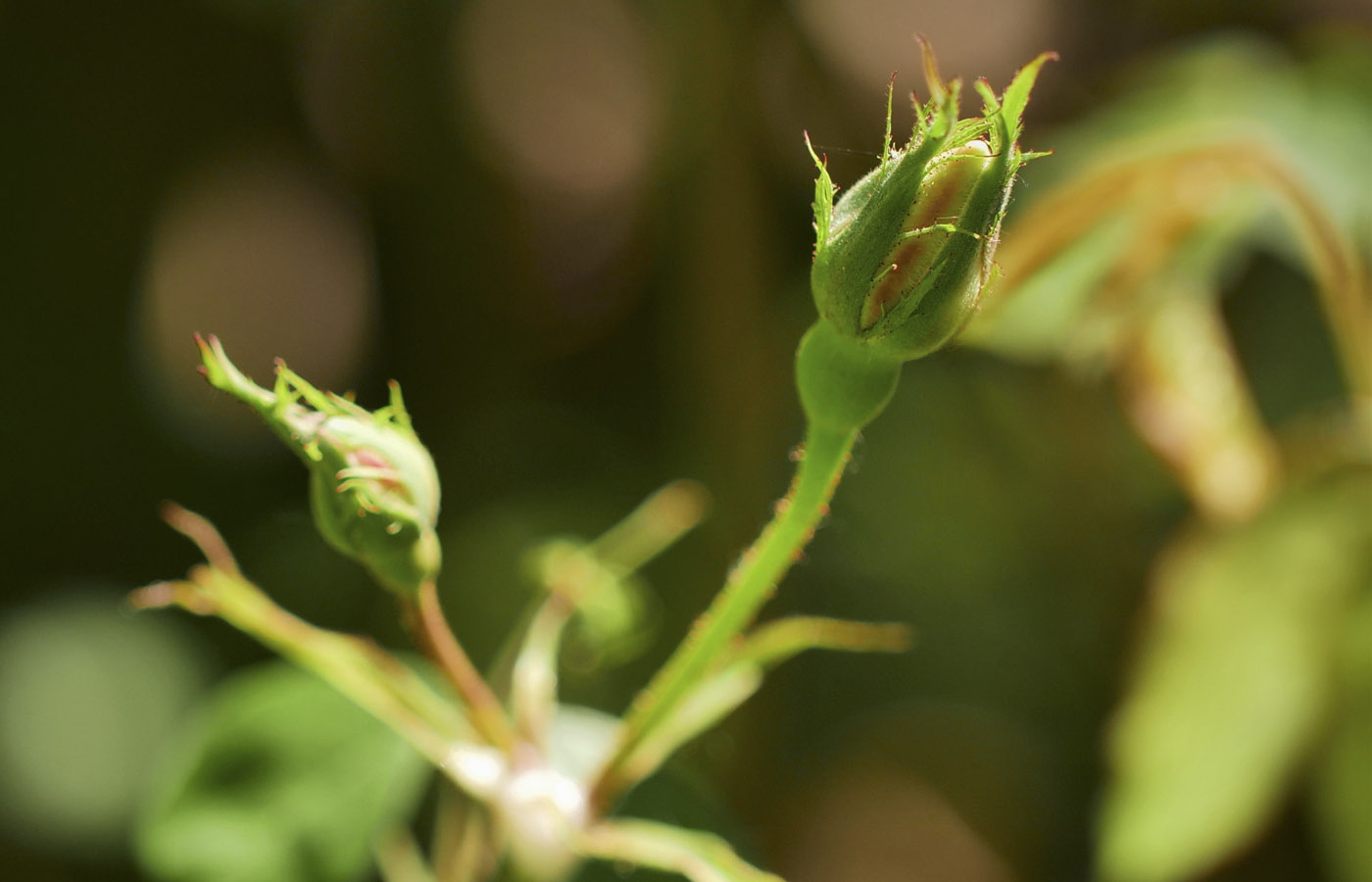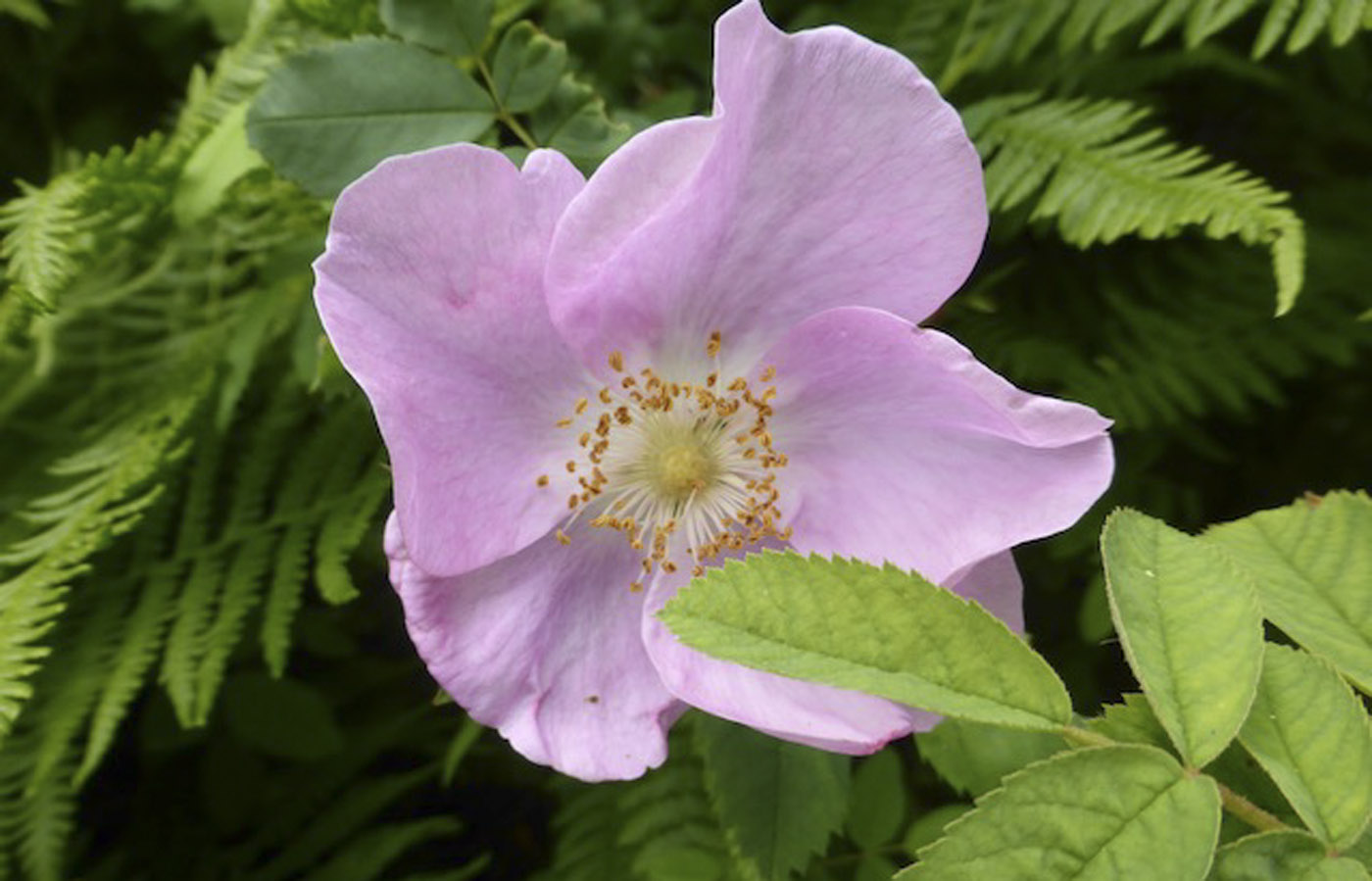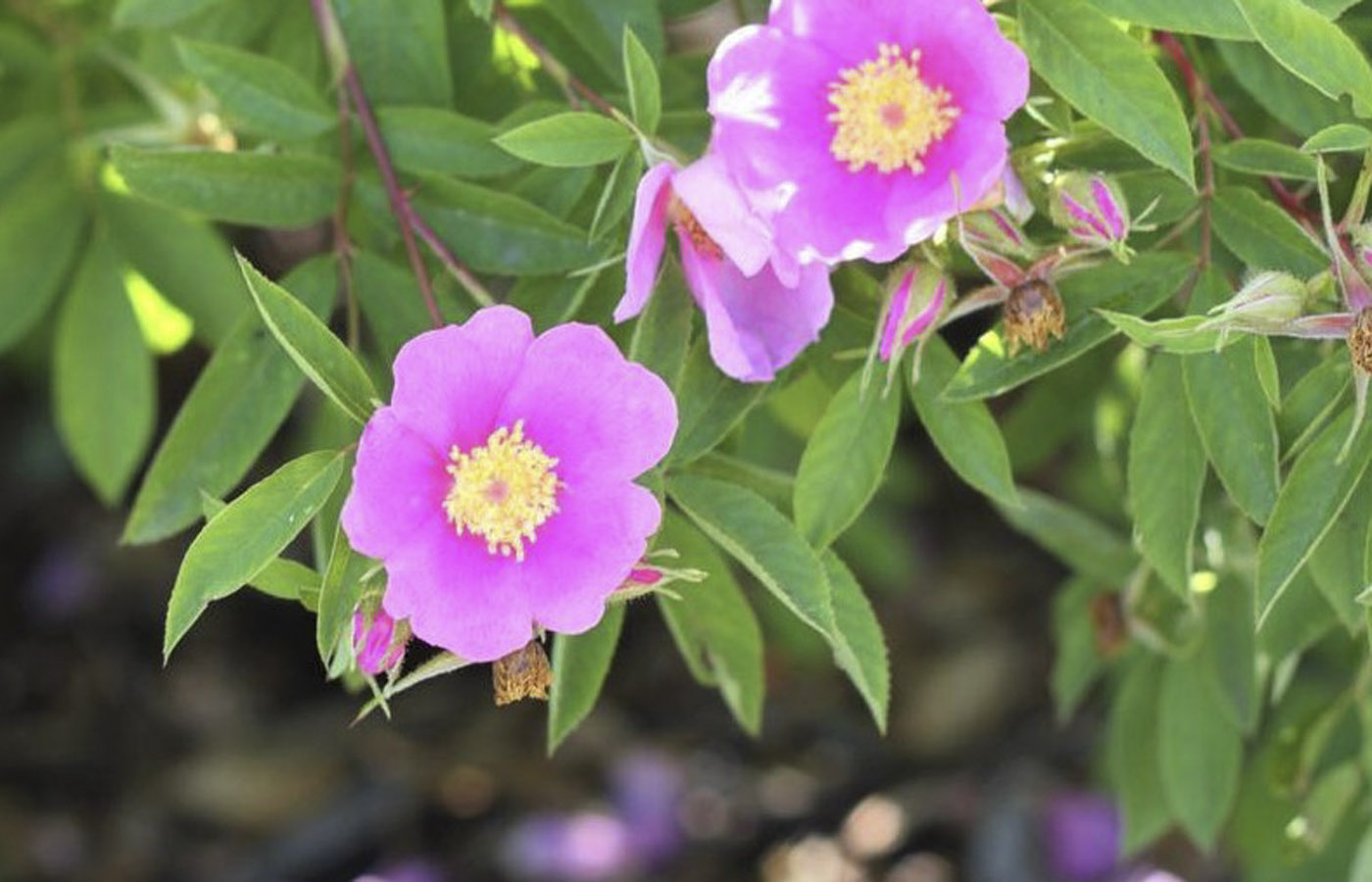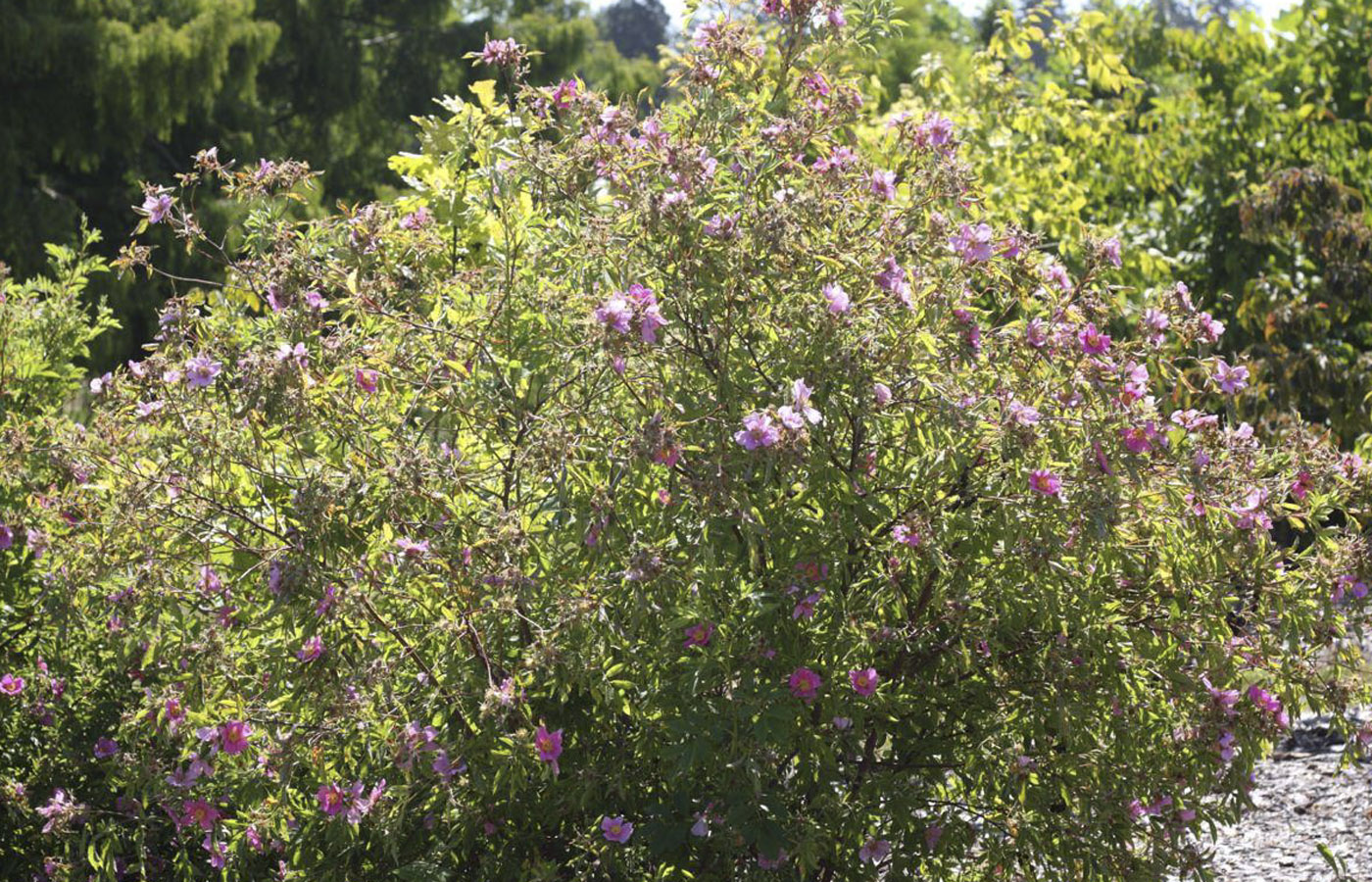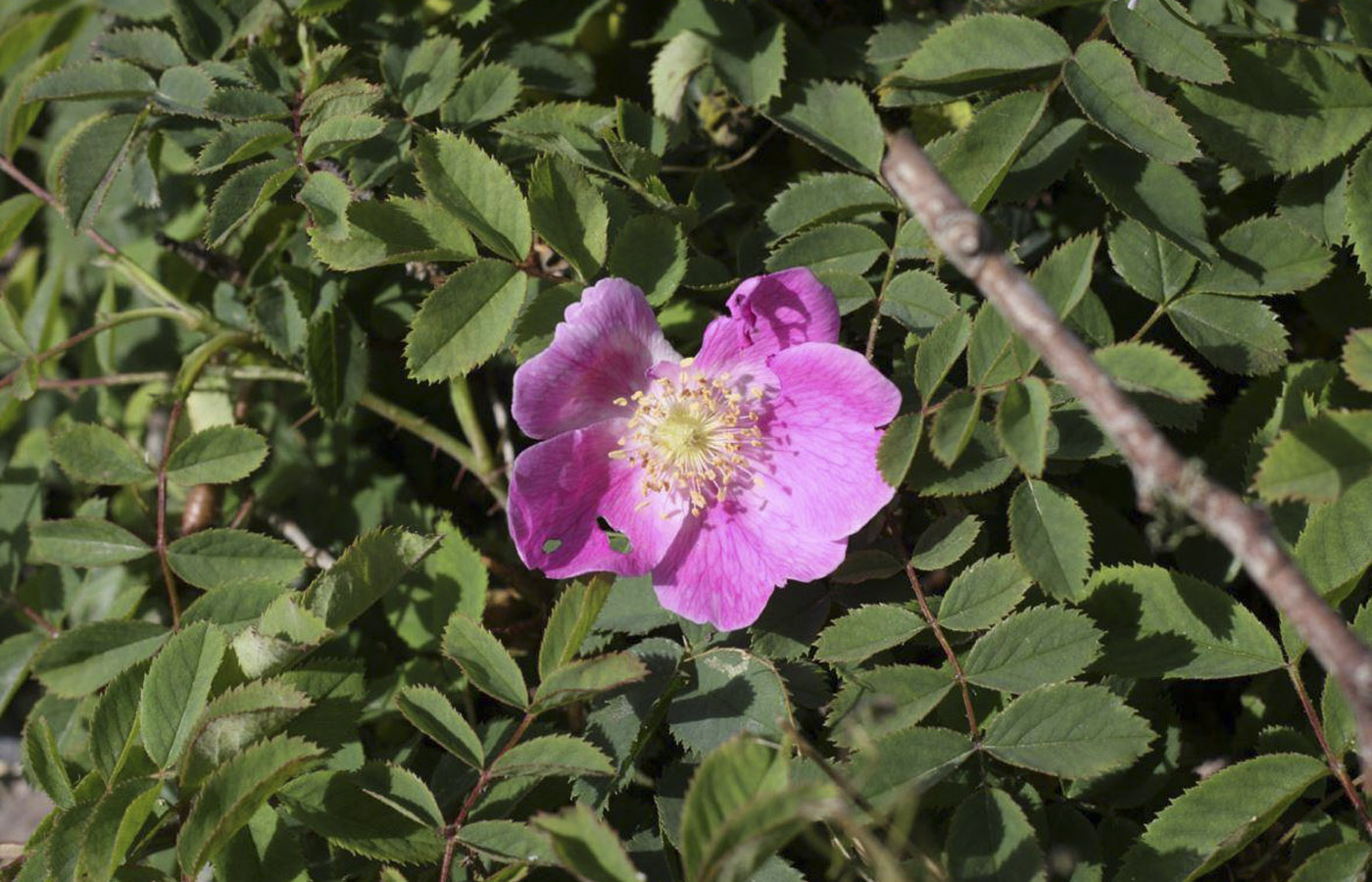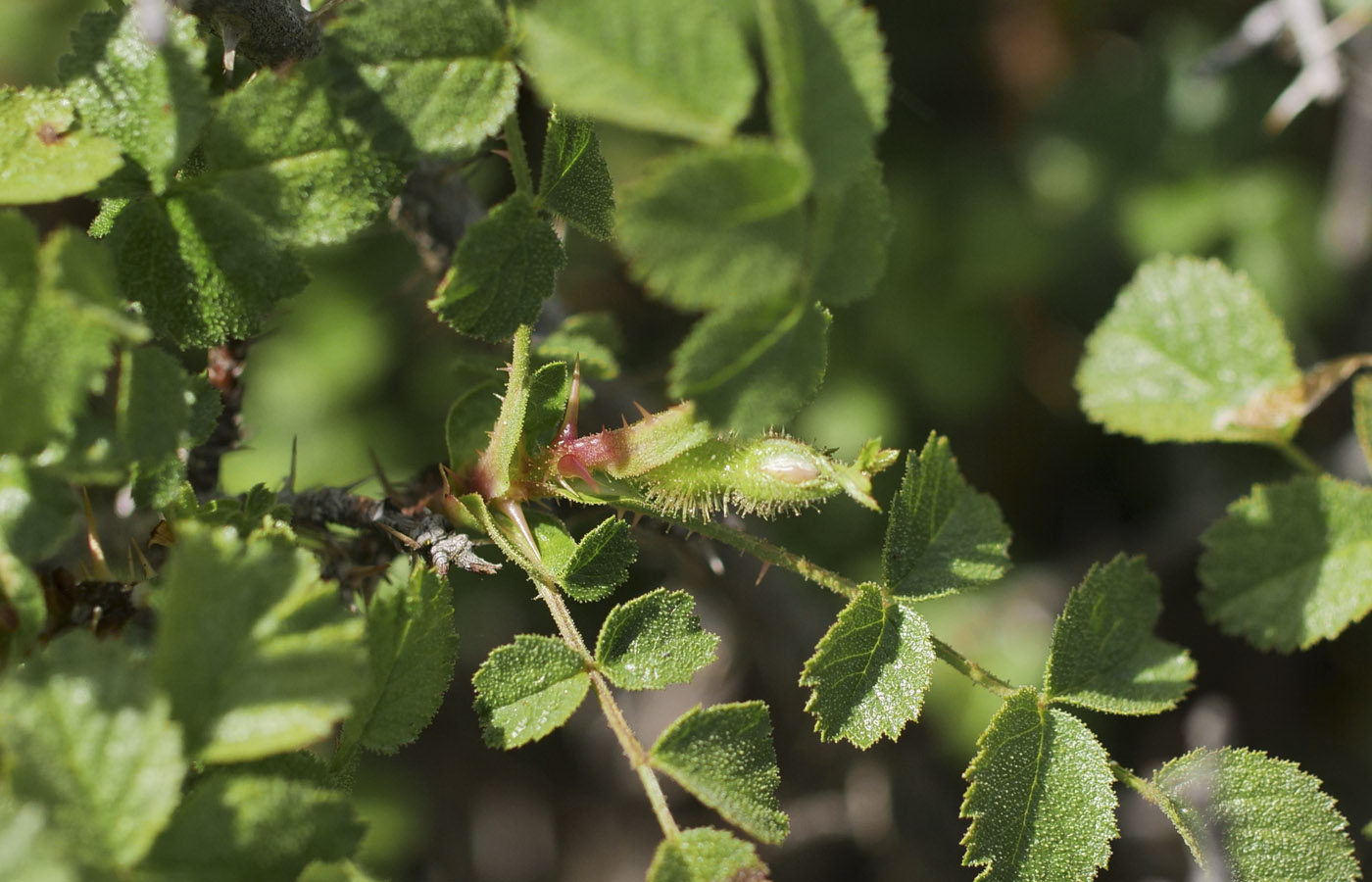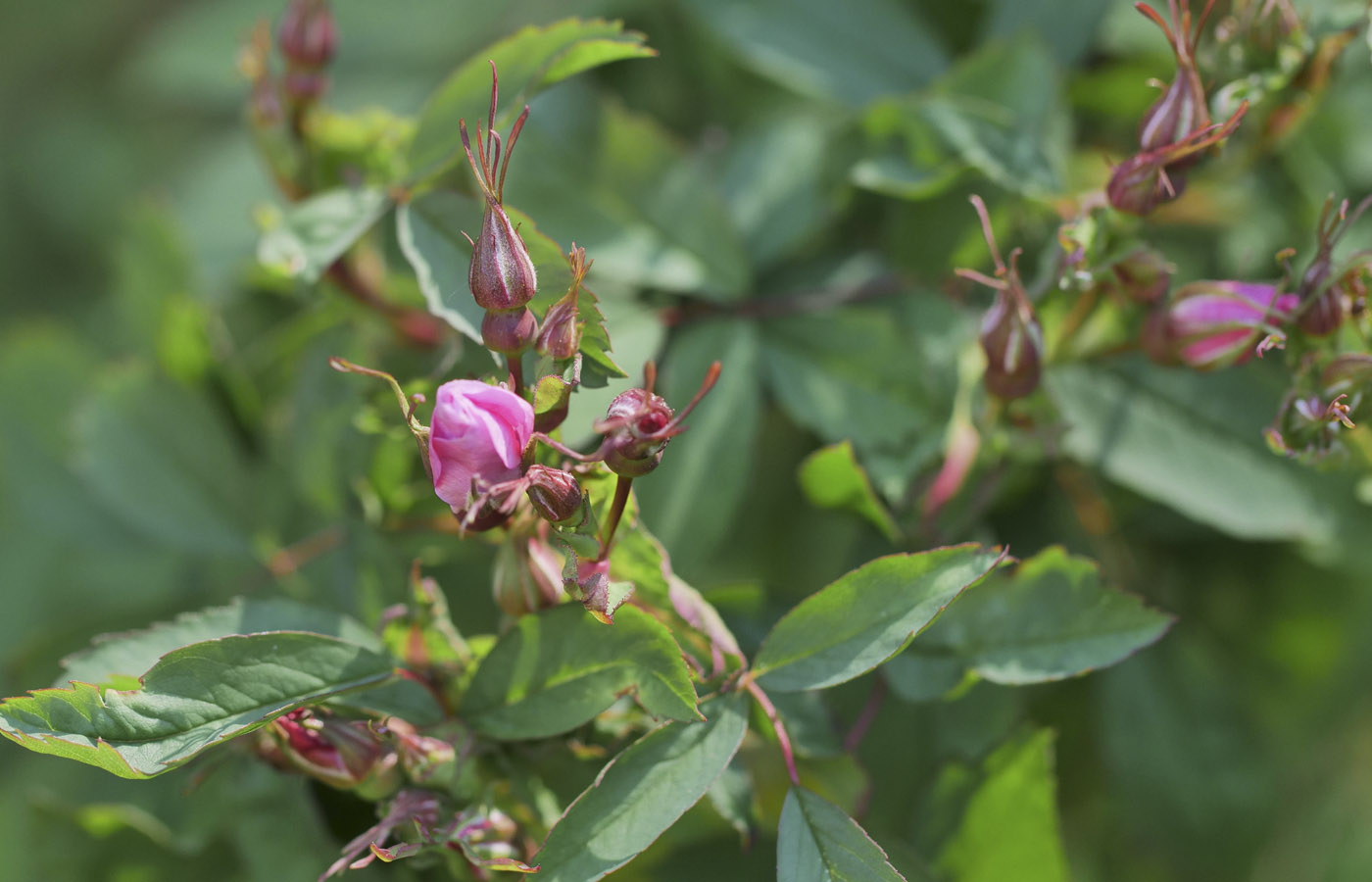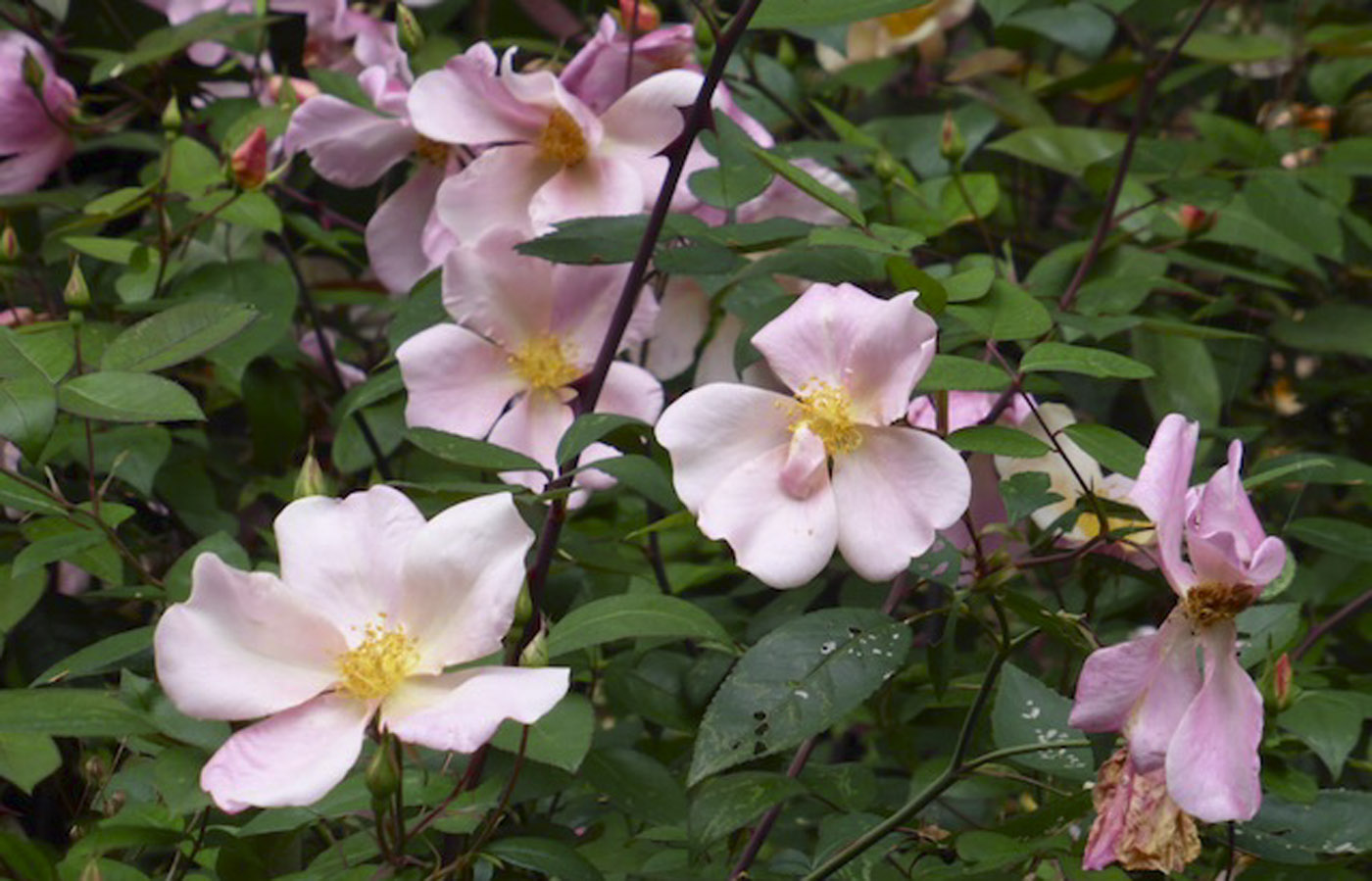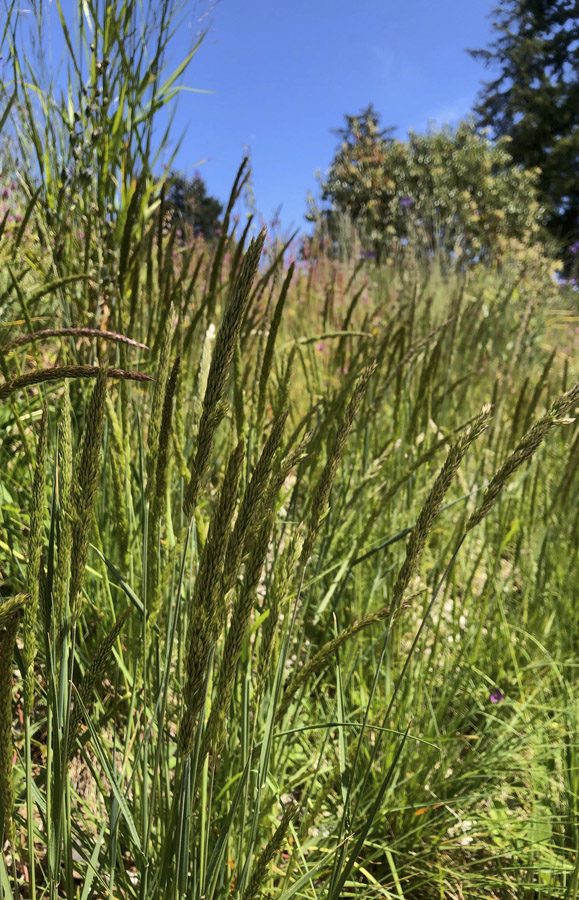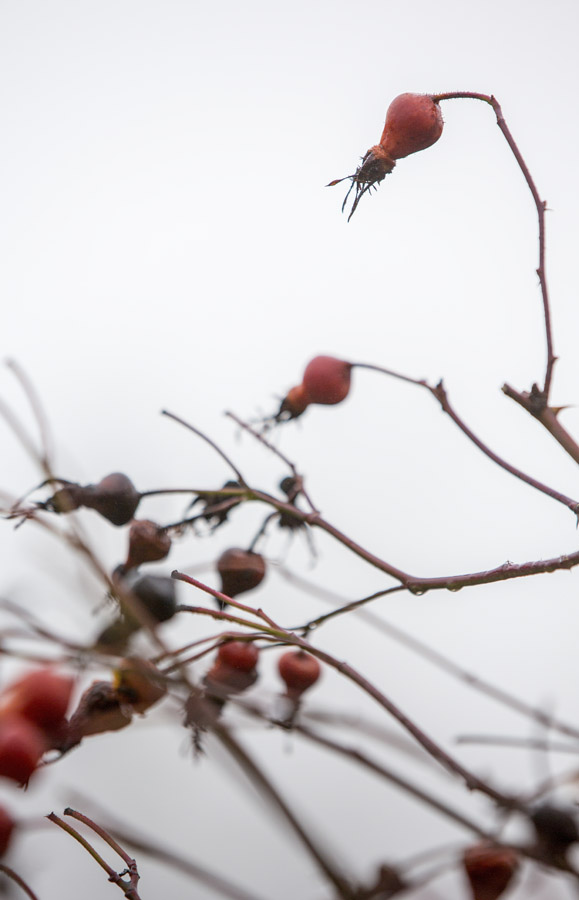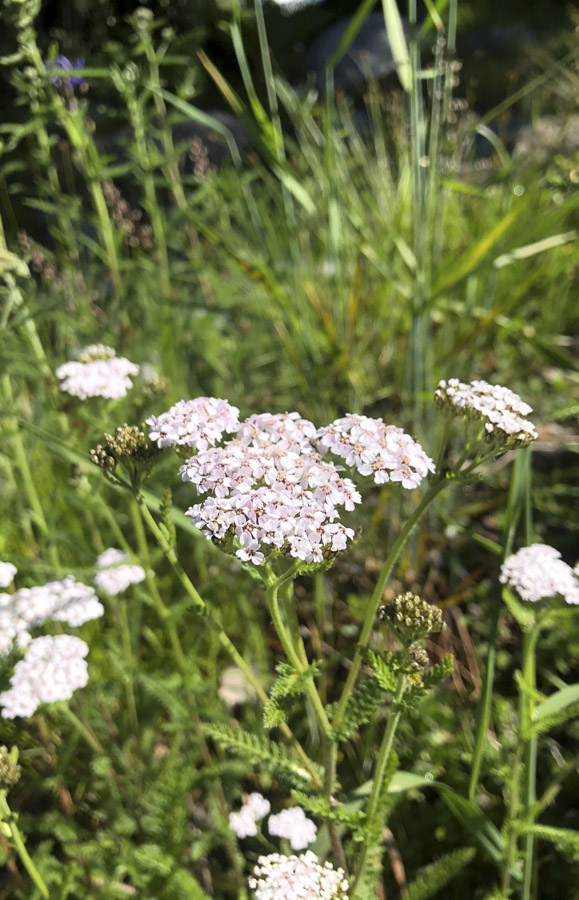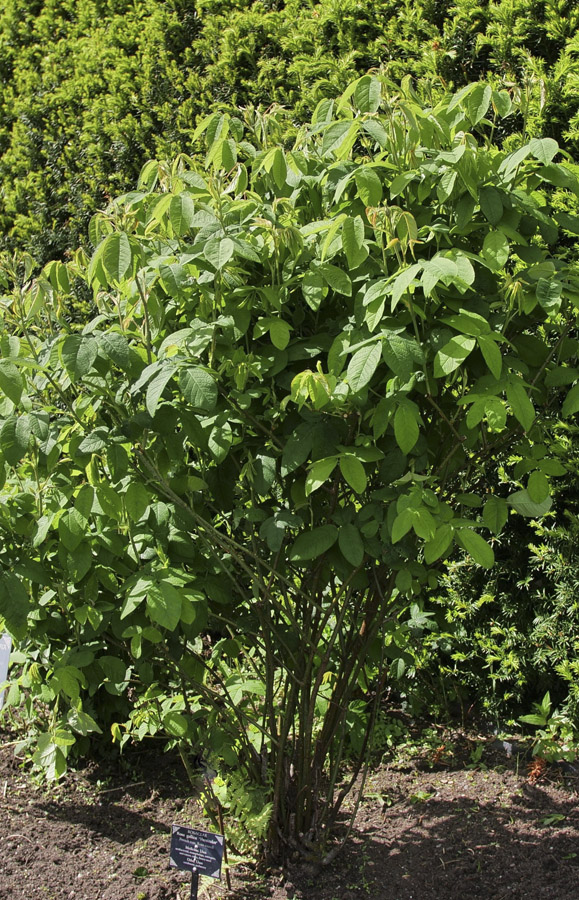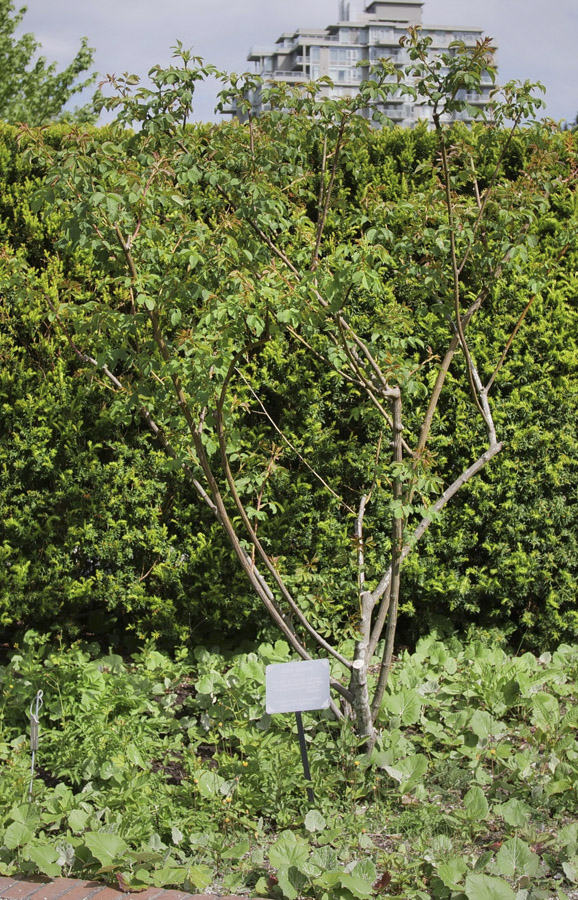For a self-guided tour, use Garden Explorer to locate plants featured in this month’s post. Select a tour in the drop-down menu.
June is a very good month for viewing plants and abundant flowers in UBC Botanical Garden. In particular, look out for roses. The Garden’s collection does not include the classic hybrid tea roses of formal gardens; rather, the majority of our roses are wild plants.
Every rose should have its due—they’re all wonderful plants—but given the limited space here I can’t hope to cover all the roses in the Garden. And forgive me for making a few digressions away from roses to other notable plants on our way around the Garden on this tour.
In the David C. Lam Asian Garden, primarily Chinese and Himalayan species clamber over large shrubs and climb up trees. Note, for example, the exquisitely fragrant blooms of Rosa helenae (Upper Asian Way near Fortune Trail), Rosa henryi (on Delavay west of Kingdon Ward Way) and especially, the magnificent Rosa filipes ‘Kiftsgate’ (where Forrest Trail and Rock Trail meet). These climbers are all from China or the Himalayas and nearly all of them have similar hooked prickles on exceptionally long stems that climb, sprawl or recline. They have prickles on their leaves and leaf stalks, and sizeable clusters of usually smallish, but oh, so fragrant white flowers. Botanical descriptions typically state that they grow 6 to 10 m, but here, several species have surpassed 25 m tall after 35 years, ascending mature conifers.
Two cultivated roses in the Asian Garden are also worth looking out for. Rosa ‘Cooper’s Burmese’ (on the fence just past the Snack Shack) is an evergreen climber with impossibly glossy, dark green leaves. In June, it produces a lavish display of enormous, single white flowers. The other rose is an exceptional shrub, R. x odorata ‘Mutabilis’ (Upper Asian Way at Stearn Trail). Often called the butterfly rose, this early hybrid bears purple new growth and lightly-scented flowers that open a light buff-yellow from vermilion flower buds. After a day or so they change to coppery pink and finally darken to deep crimson. From early summer until frost, flowers of different stages are present on the plant at the same time (mutabilis = changing).
Passing through the Moon Gate and Tunnel leads to an altogether different environment—one characterized by openness and sunlight (at least, when it’s sunny). Following the main path up through the Garry Oak Meadow Garden are more roses, primarily our native, shrubby, Nootka rose, Rosa nutkana var. nutkana. The clear pink flowers of this species are the largest of all of our native roses.
Many of the flowers of the early herbaceous plants in the Garry Oak Meadow Garden mentioned in last month’s entry will have withered by now, but the flat-topped blooms of yarrow, Achillea millefolium will be prominent on the slope near the stairs. And further up the path, perennial woolly sunflowers, Eriophyllum lanatum, will greet June visitors with their sunny yellow daisies.
Flowering in grasses is seldom remarked upon, but all around this area are carpets of the beautiful June grass, Koeleria macrantha, with its delicate plume-like flower stalks. June grass is native to prairie habitats across North America and Eurasia and is an important component in the recent renovation here. Ben Stormes, curator of North American Gardens has spent a number of years with Garden staff clearing the Garry Oak Meadow Garden of invasive European grasses and weeds and replacing them with local Garry oak ecosystem natives. What you see today is the result of their hard work.
The Carolinian Forest comes alive in late spring/early summer with deciduous azaleas from southeastern North America. The latest of our azaleas to flower, Rhododendron calendulaceum (flame azalea) and R. arborescens (sweet azalea) will still have something to show in June. Flame azalea has yellow to brilliant orange unscented flowers, while the white to pink flowers of sweet azalea are intensely fragrant with hints of clove and persimmon. These and other North American azaleas are more garden worthy than most people recognize.
Nearby, are a few plantings of Kalmia latifolia (mountain laurel). This unusual rhododendron relative is distributed in the forests across the eastern United States. The individual white to pink flowers are extraordinary at all stages. When expanding, the flower buds are studded with curious-looking, evenly-spaced bumps. As the flowers open, the reason for the bumps becomes clear. Pollen-bearing anthers at the tips of the stamens are seated in pockets that form the bumps on the outside. When ripe, the bent-over stamens are like trip-wires for unsuspecting bees and other pollinators. Once tripped, the undersides of these insects will be bombarded with pollen.
There are other amazing plants in the Carolinian Forest. Bigleaf magnolia, Magnolia macrophylla, for example, can grow 30 m tall Both its leaves and flowers are the largest of all magnolias. Although our trees are still small, they are much admired for their thick, sparse branching, huge white-backed leaves and salad bowl-sized white flowers that appear in June and July. At the far end of the Carolinian Forest in Marshall Grove is an ever-widening thicket of the eastern North American swamp rose, Rosa palustris. The single pink flowers of this suckering, shrubby rose have a lovely fruity aroma.
Just like in May, the floral bounty of the Garden in June is practically too great to catalogue in one feature. The E.H. Lohbrunner Alpine Garden in particular is awash in flowers, including a couple of smaller roses. Rosa pulverulenta is a prickly dwarf rose with single pink flowers, native from around the Mediterranean east into western Asia. The flowers are sweetly fragrant, but the glandular leaves smell strongly of pine—though you might need to get on your hands and knees to test this. You can find R. pulverulenta in the African section as well as in Asia Minor. In the European section the mat-forming, pink-flowered “alpine rose,” R. pendulina is somewhat shy flowering, but usually throws a few flowers out in June. The flowers look pretty against the modest mat of blue-green foliage.
If European roses are your thing, don’t miss the display in the Harold & Frances Holt Physic Garden—including the famous York and Lancaster rose, R. x damascena ‘Versicolor’ with its red, white and mottled double flowers. Single pink flowers adorn the sweet briar rose or eglantine, R. rubiginosa, apothecary rose, R. gallica, and dog rose, R. canina. A classic old garden rose with semi-double, mottled red-and-white flowers is rosa mundi, R. gallica ‘Versicolor’. All of these have heady fragrances. For even more exuberant hybrid roses, there are several in the Contemporary Garden.
Finally, you can see nearly all of BC’s native roses in the BC Rainforest Garden. The most floriferous and rampant is a selection of the pink-flowered Wood’s rose, R. woodsii var ultramontana ‘Kimberley’ that was found by the Garden’s former research scientist, Wilf Nichols, near the town of Kimberley in southeastern BC. He named it ‘Kimberley’, but as Wilf himself acknowledges, this is highway rose, not a garden rose, and we have to beat it back regularly to keep it from taking over.
One of the few plants that nearly everyone can recognize, roses set themselves apart from other plants. There are certainly more than those mentioned here to discover in UBC Botanical Garden. You’re on your own to find the rest, but don’t forget to enjoy the intensely fragrant, creamy pink flowers of Rosa ‘Madame Alfred Carriere’ on the lattice behind the Reception Centre (near the parking lot), before you go.
Submitted by: Douglas Justice, Associate Director, Horticulture and Collections **Please note that some roses were not yet in bloom at the time of photographing for the feature.**
- Rosa gallica ‘officinalis’ Photo by Adriana Lopez-Villalobos, Curatorial Coordinator.
- Eriophyllum lanatum Photo by Douglas Justice, Associate Director, Horticulture & Collections.
- Kalmia latifolia Photo by Douglas Justice, Associate Director, Horticulture & Collections.
- Magnolia macrophylla Photo by Douglas Justice, Associate Director, Horticulture & Collections.
- Rosa canina Photo by Adriana Lopez-Villalobos, Curatorial Coordinator.
- Rosa rubiginosa Photo by Adriana Lopez-Villalobos, Curatorial Coordinator.
- Kalmia latifolia Photo by Adriana Lopez-Villalobos, Curatorial Coordinator.
- Rhododendron arborescens Photo by Douglas Justice, Associate Director, Horticulture & Collections.
- Rhododendron arborescens Photo by Douglas Justice, Associate Director, Horticulture & Collections.
- Rhododendron calendulaceum Photo by Douglas Justice, Associate Director, Horticulture & Collections.
- Rosa’Cooper’s Burmese’ Photo by Douglas Justice, Associate Director, Horticulture & Collections.
- Rosa ‘Cooper’s Burmese’ Photo by Douglas Justice, Associate Director, Horticulture & Collections.
- Rosa filipes ‘Kiftsgate’ Photo by Douglas Justice, Associate Director, Horticulture & Collections.
- Rosa helenae Photo by Douglas Justice, Associate Director, Horticulture & Collections.
- Rosa henryi Photo by Douglas Justice, Associate Director, Horticulture & Collections.
- Rosa ‘Madame Alfred Carriere’ Photo by Adriana Lopez-Villalobos, Curatorial Coordinator.
- Rosa ‘Madame Alfred Carriere’ Photo by Adriana Lopez-Villalobos, Curatorial Coordinator.
- Rosa nutkana var. nutkana Photo by Douglas Justice, Associate Director, Horticulture & Collections.
- Rosa palustris
- Rosa palustris
- Rosa pendulina
- Rosa pulverulenta Photo by Adriana Lopez-Villalobos, Curatorial Coordinator.
- Rosa woodsii var. ultramontana ‘Kimberley’ Photo by Adriana Lopez-Villalobos, Curatorial Coordinator.
- Rosa x odorata ‘Mutabilis’ Photo by Douglas Justice, Associate Director, Horticulture & Collections.
- Koeleria macrantha Photo by Ben Stormes, Curator and Horticulturist, North American Gardens.
- Rosa x damascena ‘Versicolor’ Photo by Daniel Mosquin, Research Manager.
- Achillea millefolium Photo by Ben Stormes, Curator and Horticulturist, North American Gardens.
- Rosa gallica’Versicolor’ Photo by Adriana Lopez-Villalobos, Curatorial Coordinator.
- Rosa canina Photo by Adriana Lopez-Villalobos, Curatorial Coordinator.

